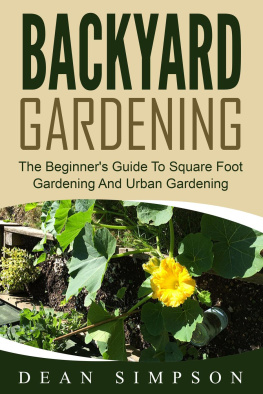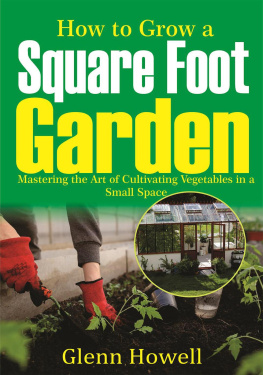Mel Bartholomew - Square Metre Gardening
Here you can read online Mel Bartholomew - Square Metre Gardening full text of the book (entire story) in english for free. Download pdf and epub, get meaning, cover and reviews about this ebook. publisher: Frances Lincoln, genre: Children. Description of the work, (preface) as well as reviews are available. Best literature library LitArk.com created for fans of good reading and offers a wide selection of genres:
Romance novel
Science fiction
Adventure
Detective
Science
History
Home and family
Prose
Art
Politics
Computer
Non-fiction
Religion
Business
Children
Humor
Choose a favorite category and find really read worthwhile books. Enjoy immersion in the world of imagination, feel the emotions of the characters or learn something new for yourself, make an fascinating discovery.

- Book:Square Metre Gardening
- Author:
- Publisher:Frances Lincoln
- Genre:
- Rating:3 / 5
- Favourites:Add to favourites
- Your mark:
- 60
- 1
- 2
- 3
- 4
- 5
Square Metre Gardening: summary, description and annotation
We offer to read an annotation, description, summary or preface (depends on what the author of the book "Square Metre Gardening" wrote himself). If you haven't found the necessary information about the book — write in the comments, we will try to find it.
Square Metre Gardening — read online for free the complete book (whole text) full work
Below is the text of the book, divided by pages. System saving the place of the last page read, allows you to conveniently read the book "Square Metre Gardening" online for free, without having to search again every time where you left off. Put a bookmark, and you can go to the page where you finished reading at any time.
Font size:
Interval:
Bookmark:


Mel Bartholomew

Frances Lincoln Ltd
www.franceslincoln.com
First Frances Lincoln edition 2013
2013 Cool Springs Press
Text 2013 Square Foot Gardening Foundation
All rights reserved. No part of this publication may be reproduced, stored in a retrieval system or transmitted in any form, or by any means, electronic, mechanical, photocopying, recording or otherwise, without either permission in writing from the publisher or a licence permitting restricted copying. In the United Kingdom such licences are issued by the Copyright Licencing Agency, Saffron House, 6-10 Kirby Street, London EC1N 8TS.
A catalogue record for this book is available from the British Library.
Digital Edition: 978-1-78101-119-5
Softcover Edition: 978-0-71123-452-9
UK consultant: Liz Dobbs
Design: Schermuly Design Co.
Proofreading and index: Marion and Michael Dent

I know you will be successful with my Square Metre Gardening method, not only because I have spent over 30 years perfecting it but because of all the hundreds of people who have got in touch to let me know how much food they get from such a small space with such little effort. Heres a taste of how I figured it all out.

Lettuce is one of the easiest crops to grow and it comes in a variety of colours.
Growing your own crops is a lot of work if you follow traditional methods. Luckily my observations and experiments on sowing and planting in garden situations show there is a better way.

Mel Bartholomew
I t all started in 1975 after my retirement from my consulting engineering business, I decided to take up gardening as a hobby but I soon began to question the efficiency of all the conventional gardening practices wed been taught. Why is fertiliser spread over the entire garden area, but the plants are only placed in long rows with wide paths on both sides? I wondered why you were supposed to cultivate all the soil in a garden even though plants in rows take up a fraction of the space. Then I pondered why you would walk all over the rest of the ground again, packing down all that newly cultivated soil? And, why, in this era of water conservation, is an entire plot sprinkled with water when the plants are only located in a 15-cm (6-inch) wide row in the centre of a 2-m (6-foot) wide strip?
As I analysed these traditional gardening methods, I realised there is only one outcome you can expect when you fertilise and water ground and paths with nothing planted in it weeds!
Why plant an entire row of everything? Just because my kitchen garden is 10m (30ft) wide, for example, do I really want or need a whole 10m (30ft) row of cabbages? That would be at least thirty cabbages spaced 30cm (12in) apart. Why would I want thirty cabbages to be ready all at the same time? If everything is planted at one time, wont it also be ready to harvest all at once? It sounds like farming to me, but thats too much cabbage to enjoy at the same time for a homeowner. How many people go to the shops and buy thirty heads of cabbage once a year? Do you? So why grow it that way? There must be a better way to stagger the harvest, and the obvious solution is to stagger the time of planting whenever possible and to plant less.
I sought answers to all my gardening questions and, no matter where I travelled, I kept receiving the same answer, Because thats the way weve always done it! Right then and there I said, Im going to invent a better way to garden.
Part of the problem, I realised, was that single-row gardening was nothing but a hand-me-down technique from large-field arable farming. Single rows make sense when you depend upon a tractor to plough up the soil but in a home garden, there is no longer a need for all that wasted space.

Planting in long rows is traditional but do you really want all those cabbages? My Square Metre Gardening method concentrates on growing family-sized portions in a smaller area so there is less wasted space and less work.
Eager to test my reasoning, I planted two rows, 15cm (6in) apart, to see how well the plants would do. It worked! The plants grew just as well in two rows as they did in a single row, as long as each plant had 15cm (6in) all around. Next, I tried a triple row three rows where I placed all the plants 15cm (6in) apart in all directions. Again, it worked! How wide could I make this, I asked? The answer is, as wide as you can reach in to maintain your garden; in other words, as long as your arms. But I still had a harvest too large to utilise.
So what was the obvious solution? Shorten the rows! And they kept getting shorter and shorter, until they were only 30cm (12in) long and 30cm (12in) wide a small square planting area that would hold four plants per square if each plant was 15cm (6in) apart.
In summary, if plants should be thinned to 30cm (12in) apart, plant one per square. If plants should be 15cm (6in) apart, plant four per square. If plants should be 10cm (4in) apart then you can grow nine within the space of that one square. If plants are thinned to 8cm (3in) apart, you can grow sixteen in that same square. Doesnt it all make sense and seem easy enough?
I also realised that if each square could be planted with a different crop containing either one, four, nine or sixteen plants, all properly spaced, it wouldnt be necessary to plant a whole row of just one crop. If youre farming for commercial purposes, you want everything to ripen at once so it can be harvested together and taken to market. But with home gardening, you want to stagger harvesting your produce so you can pick little-and-often throughout the season with fresh pickings each day or so.
Square-metre gardening (SMG) is a simple, foolproof method of growing your own delicious vegetables and herbs, no matter how small your growing space
After perfecting my sowing and planting experiments, my rows got shorter and shorter until I eventually hit upon the idea of growing in 1-metre (3-ft) box frames, edged with timber boards to create raised beds. These are, in turn, divided with a lattice of wooden laths that form a planting grid of nine squares, each measuring 33 x 33 cm (13 x 13in). In practice, due to the width of the lath, a planting square of 30 x 30cm (12 x 12in).
Into these squares I plant, or sow, different numbers of crops depending on their size at maturity. If plants need to be spaced 30cm (12in) apart, e.g. cauliflower, I grow one plant in each square; if they need to be spaced 15cm (6in) apart, e.g. lettuce, I grow four plants in each square; if 10cm (4in) apart, e.g. parsley, I grow nine; and if 8cm (3in) apart, e.g. carrots, I grow 16. What could be simpler?
Font size:
Interval:
Bookmark:
Similar books «Square Metre Gardening»
Look at similar books to Square Metre Gardening. We have selected literature similar in name and meaning in the hope of providing readers with more options to find new, interesting, not yet read works.
Discussion, reviews of the book Square Metre Gardening and just readers' own opinions. Leave your comments, write what you think about the work, its meaning or the main characters. Specify what exactly you liked and what you didn't like, and why you think so.





